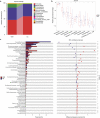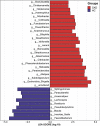Alterations of the Human Gut Microbiome in Chronic Kidney Disease
- PMID: 33101877
- PMCID: PMC7578882
- DOI: 10.1002/advs.202001936
Alterations of the Human Gut Microbiome in Chronic Kidney Disease
Abstract
Gut microbiota make up the largest microecosystem in the human body and are closely related to chronic metabolic diseases. Herein, 520 fecal samples are collected from different regions of China, the gut microbiome in chronic kidney disease (CKD) is characterized, and CKD classifiers based on microbial markers are constructed. Compared with healthy controls (HC, n = 210), gut microbial diversity is significantly decreased in CKD (n = 110), and the microbial community is remarkably distinguished from HC. Genera Klebsiella and Enterobacteriaceae are enriched, while Blautia and Roseburia are reduced in CKD. Fifty predicted microbial functions including tryptophan and phenylalanine metabolisms increase, while 36 functions including arginine and proline metabolisms decrease in CKD. Notably, five optimal microbial markers are identified using the random forest model. The area under the curve (AUC) reaches 0.9887 in the discovery cohort and 0.9512 in the validation cohort (49 CKD vs 63 HC). Importantly, the AUC reaches 0.8986 in the extra diagnosis cohort from Hangzhou. Moreover, Thalassospira and Akkermansia are increased with CKD progression. Thirteen operational taxonomy units are correlated with six clinical indicators of CKD. In conclusion, this study comprehensively characterizes gut microbiome in non-dialysis CKD and demonstrates the potential of microbial markers as non-invasive diagnostic tools for CKD in different regions of China.
Keywords: chronic kidney disease; gut microbiome; microbial markers; non‐invasive diagnostic tools.
© 2020 The Authors. Published by Wiley‐VCH GmbH.
Conflict of interest statement
The authors declare no conflict of interest.
Figures







Similar articles
-
Characteristics of human oral microbiome and its non-invasive diagnostic value in chronic kidney disease.Biosci Rep. 2022 May 27;42(5):BSR20210694. doi: 10.1042/BSR20210694. Biosci Rep. 2022. PMID: 35348181 Free PMC article.
-
Characterizing the gut microbiota in patients with chronic kidney disease.Postgrad Med. 2020 Aug;132(6):495-505. doi: 10.1080/00325481.2020.1744335. Epub 2020 Apr 2. Postgrad Med. 2020. PMID: 32241215
-
Alterations to the Gut Microbiota and Their Correlation With Inflammatory Factors in Chronic Kidney Disease.Front Cell Infect Microbiol. 2019 Jun 12;9:206. doi: 10.3389/fcimb.2019.00206. eCollection 2019. Front Cell Infect Microbiol. 2019. PMID: 31245306 Free PMC article.
-
Gut Microbiota in Chronic Kidney Disease: From Composition to Modulation towards Better Outcomes-A Systematic Review.J Clin Med. 2023 Mar 1;12(5):1948. doi: 10.3390/jcm12051948. J Clin Med. 2023. PMID: 36902734 Free PMC article. Review.
-
Microbiome in Chronic Kidney Disease (CKD): An Omics Perspective.Toxins (Basel). 2022 Feb 26;14(3):176. doi: 10.3390/toxins14030176. Toxins (Basel). 2022. PMID: 35324673 Free PMC article. Review.
Cited by
-
Microbiome-Metabolomics Analysis Reveals the Protection Mechanism of α-Ketoacid on Adenine-Induced Chronic Kidney Disease in Rats.Front Pharmacol. 2021 May 11;12:657827. doi: 10.3389/fphar.2021.657827. eCollection 2021. Front Pharmacol. 2021. PMID: 34045965 Free PMC article.
-
Alteration of the Gut Microbiome in Chronic Kidney Disease Patients and Its Association With Serum Free Immunoglobulin Light Chains.Front Immunol. 2021 Apr 1;12:609700. doi: 10.3389/fimmu.2021.609700. eCollection 2021. Front Immunol. 2021. PMID: 33868230 Free PMC article.
-
The compositional and functional imbalance of the gut microbiota in CKD linked to disease patterns.J Transl Med. 2024 Aug 16;22(1):773. doi: 10.1186/s12967-024-05578-w. J Transl Med. 2024. PMID: 39152439 Free PMC article.
-
Circulating Trimethylamine-N-Oxide and Risk of All-Cause and Cardiovascular Mortality in Patients With Chronic Kidney Disease: A Systematic Review and Meta-Analysis.Front Med (Lausanne). 2022 Apr 1;9:828343. doi: 10.3389/fmed.2022.828343. eCollection 2022. Front Med (Lausanne). 2022. PMID: 35433743 Free PMC article.
-
Potential Associations Between Microbiome and COVID-19.Front Med (Lausanne). 2021 Dec 22;8:785496. doi: 10.3389/fmed.2021.785496. eCollection 2021. Front Med (Lausanne). 2021. PMID: 35004750 Free PMC article. Review.
References
LinkOut - more resources
Full Text Sources
